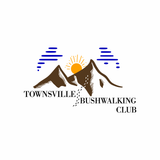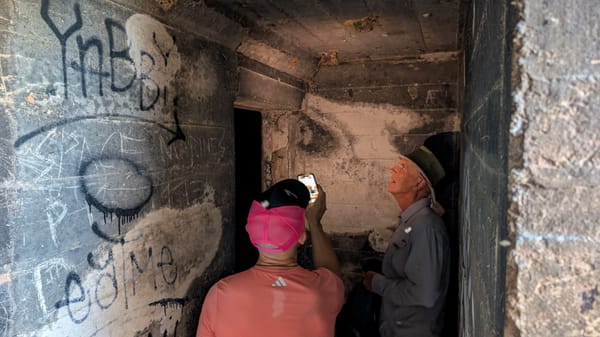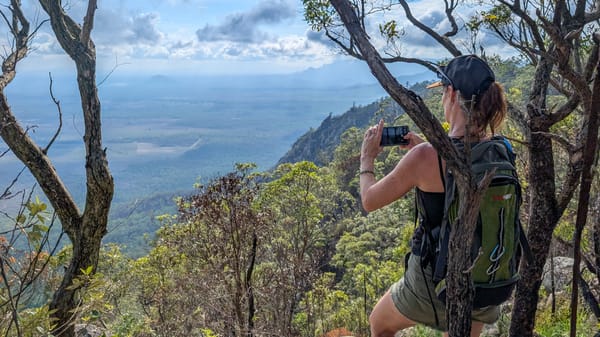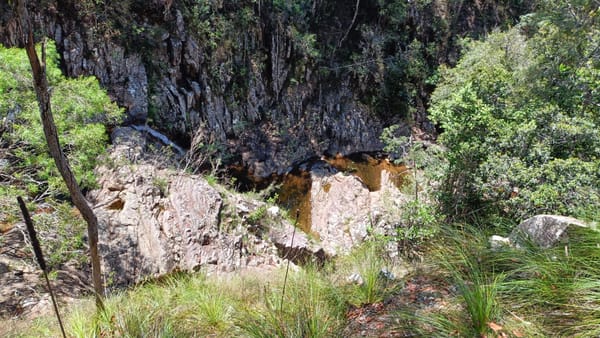Escape Magazine - June 1987
June 1987 Townsville Bushwalkers ESCAPE: Sharp Elliott epic via Double Creek, club BBQs and pub nights, Paluma Rainforest Festival, Alaska mountaineering feature, Puzzle Creek “true bug” yarn, plus first aid basics (ABC, CPR). Your guide to North Queensland bushwalking and hikes.
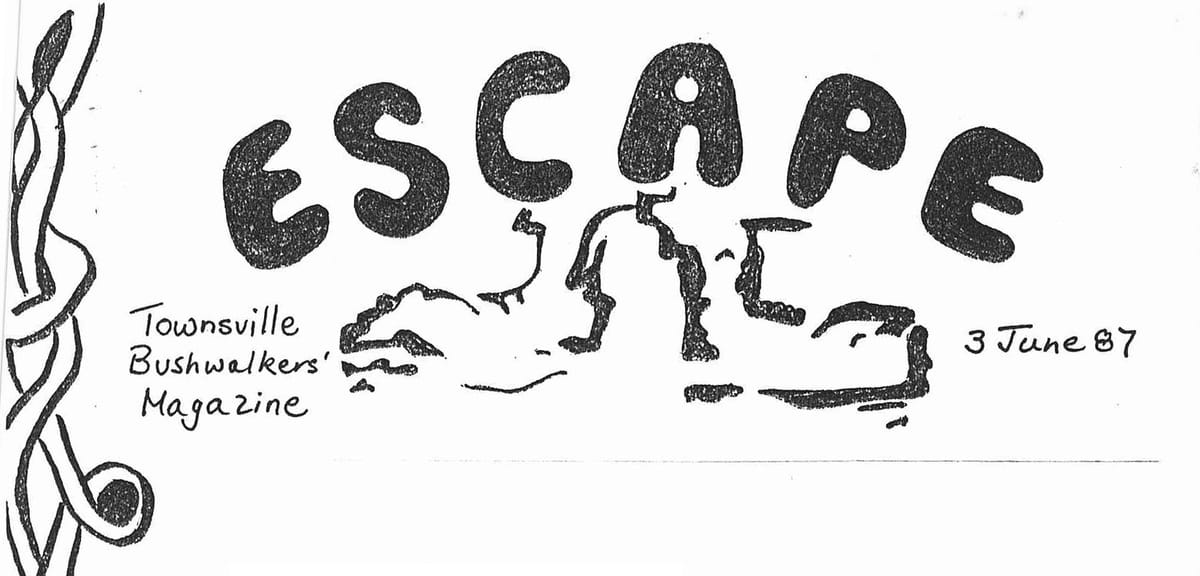
ESCAPE
Townsville Bushwalkers' Magazine
3 June 87
G'day Bushwalking Friends,
You now hold in your hands our second magazine of the year. Many thanks to those who have contributed. And again, I urge all of you to take this fantastic opportunity to become published!! The scope is wide: interstate or international travel stories, trip write-ups, recipes, jokes, cartoons and sketches, tid-bits of information for bush and wildlife fans, letters to the editor, etc. The deadline for submissions to the next issue is 22 July. Be creative!
Mary Jane
SOCIAL DIRECTOR'S REPORT
Well, we are still going to the Metropole Hotel's beer garden on the Friday night before one-day walks. The next pub night will be 12 June, so see you all there at about 6:30 pm. You don't have to eat. If your prefer, you can come later and meet everyone for drinks.
Our last barbeque was a great success. Thank you to Barbara and Allan for organizing and hosting it.
Our next barbeque will be held on Saturday 20 June at Peter Morgan's house, 2/20 Clayton Street, Hermit Park. B.Y.O. food and drinks. See you there at 5:30 pm.
Anyone who wants to have a barbeque at their house, please let me know. They are normally organized for "off" bush-walking weekends.
MARION
JUMBLE PUZZLE

PALUMA RAINFOREST FESTIVAL
July 18-19
stalls
displays
arts and crafts
Bushdance Saturday Night
For more information ring Alton Twine on 75-7233
ALASKA
Hi Everyone. I've just been overseas for a year and while I was away I did a few different things.
I went to Alaska and participated in a 33-day mountaineering course conducted by the National Outdoor Leadership School (N.O.L.S.). They deserve the excellent reputation that they have throughout North America.
There were 13 of us (2 women) and 3 instructors. The head instructor was a lady who has climbed on Everest several times and several of the Annapurras. Mind you, she was very modest about her achievements.
A bus dropped us off on the edge of the tundra and we spent the next three days walking to the toe of the Nelchina Glacier. It was a time to get used to external frame packs and the heavy plastic mountaineering double boots. The boots were great for crossing streams, as with gaitors, we could cross knee-deep water without getting wet feet.
We reached the toe of the glacier and everyone was really excited about getting onto the glacier. A tiny plane landed on the moraine and deposited our skis and food and fuel for fifteen days. (Another air drop later on dropped another fifteen days worth of supplies.)
Then it was time to gear up and learn about travelling safely on a glacier. For the next twenty-eight days we were roped up, usually with two others. The only time we could unrope was when an area that had been probed (25m circle) was declared safe for camp. There was always the danger of hidden crevasses. Whenever we were roped together we had to keep the rope taut (in case someone fell in a crevasse). This meant all members of the rope team had to go at the same pace which is quite difficult on skis, especially for the middle person who got pulled in both directions. It was quite frustrating, especially when dragging the heavily ladden sled (once every four days). That person was nicknamed "slave" and nobody spoke to them for fear of being growled at.
Over the next eight days or so we travelled up the Nelchina Glacier. The landscape seemed topsy-turvy as we would travel a few days and then stop and have lessons on techniques we would need later on when climbing peaks. We learnt about pairsking out of crevasses with heavy packs and skis on, self-arresting with an ice-axe, and use of crampons.

Distances on the glacier were always deceiving. It might take several hours to go a mile because of zigzagging around crevasses. Mountains would always seem closer that they really were. We called it the "Alaska Factor".
We then reached the Science Glacier and were right amongst the higher snow-covered peaks. We made a base camp for about ten days and climbed a different peak each night. We always used ice-axes and depending on conditions (whether snow or ice) used crampons as well. It was a fantastic feeling reaching the top of a mountain and seeing the sun rise at 3am over miles and miles of snow-covered mountains and glaciers. It definately is an absolutely magic place.
The days were quite hot and sleeping in the tents was like sleeping in a sauna. But, by late afternoon we would have down jackets on again.
We were hit by a blizzard that lasted three days and had to build ice walls around our tents. This was to stop them ending up down a crevasse somewhere. (This had happened to one of our instructors.) During the blizzard we hibernated just waking to eat and go to the toilet. A rest was what we all needed.
After the blizzard I experienced the closest I have ever been to hypothermia. I had six upper body layers on: a down jacket, a fleece jacket, a wool shirt, two long-sleeved thermal tops a and a gortex jacket. We had to do the old sleeping bag trick and it still took several hours before my teeth stopped chattering.
We then left our base camp and headed down the Science Glacier. Skiing downhill on a rope team was quite funny a people would be going all directions until the ropes went taut and we all fell over in a screaming heap.
Finally, having completed our traverse of the Chugach Range, we reached Valdez on Prince William Sound. It was great to see trees and green grass again. We were all craving peanut butter and jelly sandwiches (they were all Americans), hot showers, and toilet paper.
For anyone who wants to get a real taste of climbing snow-covered mountains, this is a trip worth considering. If any of you would like to see the photos let me know. The address for N.O.L.S. is P.O. Box AA, Lander, Wyoming, U.S.A.
MARG HAYES
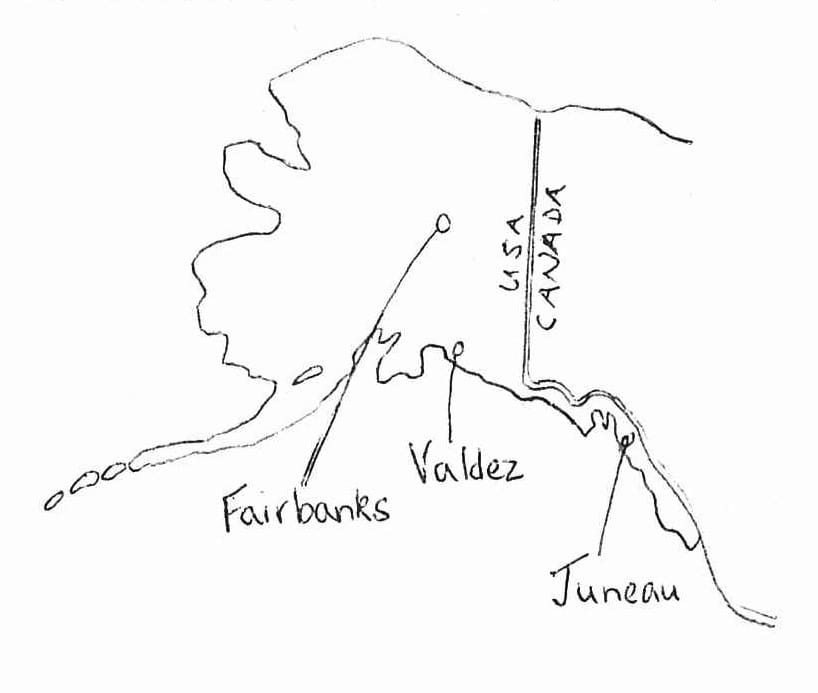
SHARP ELLIOTT
by G.Lee
The sun shone enthusiastically as we left Townsville about 7.15am. My decision to go on this walk was made with a little hesitation as the only other walkers besides Margaret and I were four "gung ho" masochists (Marg's term). However, I set off with an optimistic attitude which was only slightly dimmed by the looming rainclouds which hovered over us as we departed Pangola Park at 8.10am. We gained height quickly in this branch of Double Creek. In an open area we paused to watch an ultralight weaving through the clouds. It took 40 minutes to reach the long swimming pool at the start of the gorge. This was one of the main reasons I'd brought my Nikonas instead of my usual camera gear. The water was quite refreshing to say the least, but I was determined to swim up behind the waterfall for some shots looking out into the narrow gorge.
Not much further up the creek, we took a little detour to a lookout. As Dave put it, we would "just whizz up and take a look". Well, my meaning of "whizzing up" a steep cliff-face was a bit different to Dave's, but the view was lovely. Reluctantly we curtailed our chit chat and continued climbing. Doug kept a check on our height with his altimeter which proved invaluable. The creek abounds with lush tropical rainforest vegetation including tall tree ferns and numerous palms surrounding waterfalls. At 11.00 we stopped for smoko at the waterfall which had been the lunch spot for the previous day trip. This is a picturesque haven of palms and ferns. Just as it did on the day walk at this spot, it started raining.
It was a steep climb out of the creek at this point. I emerged to cheers from Dave, Ched and John who were sitting under the cover of a rock sheltering from the rain. "Now you know the real meaning of fear!" John said. It was here we saw an excellent specimen of gympie. A little further on, I almost pulled some gympie down on me together with a decayed tree.
At one stage, we crawled under a rock to emerge into a wall of waitawhile. As we struggled through more and more waitawhile and wet slippery rocks, we compared the difference between walking in North Qld to walking in Europe. "In Europe it's so boring with all those tracks-just one alpine scene after another. The rainforest however is just one unique, glorious step after another." (Someone was trying to keep our spirits up). And as Dave emitted a descriptive word as he untangled himself from some waitawhile, Ched remarked, "Yet another exclamation of pure satisfaction" (on the joys of bushwalking in North Qld).
At 1.00pm, we stopped for a 1/2 hour lunch, back in the creek again. At this point, Dave asked if everyone had enough food for an extra day.(Was he serious? Definitely.) After slow progress in the creek, (we'd averaged 100m in height per hour), we climbed out again. John echoed my sentiments when he said, "it's not fun any longer!" (The comments and laughter had subsided somewhat). Having left the creek, we found a grassy slope which was easier going. As it was nearing 5.00pm, we decided to collect water from a small trickle of a stream which flowed into the main branch. So, at 760m, we added 3 litre to our load and continued.
ever upwards, hoping to get in another hour of walking before darkness fell. It was to my relief that we found a campsite 20 minutes later at 950m. I was absolutely exhausted. We all found scattered spots that weren't too sloping and set up camp. With everything dripping with rain around us, it was hard to believe that in a couple of hour's time, we would be standing around a fire. But as Dave exclaimed as he sipped his cup of tea, "Ah, this is the life!", I understood Dave's persistence in getting the fire started.
The next morning, at 6.30, we started packing up in the rain and set off at 7.25 to find the elusive Sharp Elliott. This morning the walking was easier as we squished our way through the mud and decaying leaf litter. We passed numerous moss-covered rainforest giants. Near the top were a few tall palms surrounded by a hedge. I could imagine seeing a botanical garden if I peered over the hedge. At 8.10am we reached the top of Sharp Elliott at 1200 metres. We stopped for a cuppa and photos. John echoed the thoughts of some of us when he said, "I'm going to have a good look around as I'm not coming here again!" Just before we headed down at 8.40am, the skies opened up and the rains fell. We headed south west and at first it was fairly easy going, passing by some 'Tolkien country' of moss-covered dangling vines in the mist. Then there was a steep descent as we weaved through and tripped over thorny vine. I noticed many different coloured fungi and some orchids as we slid down the spur, passing through several fields of licuala palms. There were more rainforest giants, some of them fallen. Gradually, the descent became steeper and steeper as we clambered over loose, wet rocks covered with forest litter. Then steeper still; the number of rocks increasing, we encountered the elusive waitawhile again. Swinging from tree roots, we slowly made our way to the creek, being careful not to dislodge too many rocks on our fellow walkers. Ched almost stood on a baby death adder which he insisted on proving was definitely alive. It was with much relief that we entered the other branch of Double Creek for an early lunch at 11.00am and a much needed wash. The worse was over! - or so we thought!
The sun was shining above although not reaching into the creek. The boulders here were enormous, rather like Tully Gorge. After lunch, we hadn't gone 50 metres when it was obvious that to carry on meant a long drop followed by a compulsory swim. Margaret wasn't going to chance her camera, and the rest of us decided to follow her and head back up out of the creek. This section was very steep and the rocks very fragile, so I waited until the ones ahead of me had gone on and then ventured out when I thought it safe. Well, 'just when you thought it was safe to come out - ROCK!!!' You've never seen me move faster. Only a few of the rocks so far this weekend had hit their marks and I distinctly remember one stopping just above my head caught by a tree root. The adrenalin was flowing fast. The next section was a series of climbing down into the creek and back out again several times, either because the creek was impassable or very slow going as it had started to rain again and the boulders wern't diminishing in size. In fact, they didn't diminish in size until almost near the end. Meanwhile.... Dave and Doug continued in the creek while the rest of us tried our luck up the slope. At first we made quite good progress. However, it became very steep and rocky with dense patches of thorny vines. The boulders grew in size and number and we tried to make our way back into the creek. We finally dropped back into the creek at 2.45pm for another swim by yet another picturesque waterfall. Progress was slow as the boulders were large and wet and the creek steep. The sun and blue sky teased us. We could see them but couldn't reach them. The boulders were endless! On several occasions comments were made like : "I think it's flattening out now.",( but it never did), or "Does it feel like we only started yesterday? It feels like I've been here a week!" At one stage, John remarked, "Even when I stop, I'm still breathing heavily". By this time, Dave, Doug and Ched were ahead of Margaret, John and I, so we continued on and on and on...... Finally, we decided to leave the creek and cross over to the other branch. Fortunately, we came out just where the cars were parked. It was now 5.15pm. We then discovered that Ched hadn't arrived. He had obviously continued further downstream, but emerged about 15 minutes later.
So, the walk itself abounds with some very beautiful rainforest, and if you would like to experience this unique wilderness, Dave will be only too pleased to lead another trip. But as John remarked on the top of Sharp Elliott (and there are four of us who would agree) - "I'm not coming here again!"
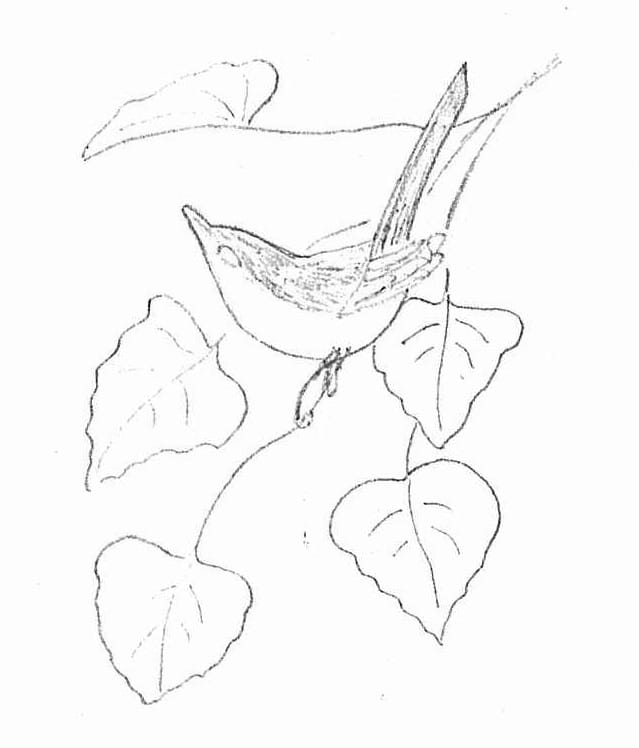
IT'S A BUG
It was the Puzzle Creek walk. Two new bushwalkers to me had complemented the group to our total of eight. Victor, I learned, was from Barcelona and temporarily with James Cook University as a research entomologist specialising in lepidoptery. Occasion for utilising this new found wealth of natural lore soon presented itself in the form of an unusual looking insect that had allighted itself upon Charlie's pack.
Victor was nearby and was eagerly summoned with an expectant cry of, "What's this, Victor?" Victor accommodatingly responded and those nearby circled in respectful silence while he studiously inspected the specimen.
With hushed anticipation we followed his examination and waited expectantly.
Shortly, Victor looked up to the patiently trustful throng and with satisfaction announced, "It's a bug!" Trustful expectation instantaneously turned to indignation. "A bug!", we exclaimed, "Is that what years of zoology and entomology are good for!" The status of entomology had reached its nadir. Victor was taken aback. What had he done to earn such indignation? Disbelief was writ large over seven faces. "A bug", he repeated, adding to the disbelief. "A hemiptera, one of the 'true bugs'." Now that sounded more like what we'd been waiting for. "A 'true bug!'." "What's a true bug?" we asked.
True bugs have piercing and sucking mouth parts specialised as a beak (rostrum). They belong to the order hemiptera and particularly the sub-order heteroptera, he explained.
Relief was felt by all as the shock and mystery of it all gradually became apparent.
Later, that night we were still chuckling about, "It's a bug."
Ched. Twyman
RELAXATION
AND NOW . . . THE THIRD AND FINAL INSTALLMENT OF HARRY'S EXCITING ADVENTURE AT JUNIPER GULF . . . . . . . . .
But, the die was cast - he was already on his way. Long before we saw him we could hear his gasps as he made his way upwards. Then his pain-ridden face, and thinking a bit of moral support the only thing we could give him, we mouthed such things as "Keep going, George!" Now, only a few feet below us, at the "change over", he gave a terrible backwards lurch, recovered, and came on. His breathing was now a moan and a yelp, tears streaming down down his cheeks - our encouragements froze on our lips as we realized he could neither hear nor see us - he was fighting desperately for his life! His tearful eyes were fixed irrevocably on his hands - he was WILLING them to open and close - to grasp, and so cheat the horrible Spectre looking over his shoulder. Slower and slower - "Oh, don't stop, George!" - but nearer and nearer, until Jack King, a burly fellow, who had slung himself over the edge with a couple of abseil girdles could grab him by the back of his singlet, and haul him up the last three rungs!
Even the redoulable Cliff was quite put out by the climb, and gave it some unprintable words. We never even tried to raise ladder or line. On recovery we made a bee line for the surface. But, even then we had minor trouble - no sentry atop the 80ft. "Green Daylight" pitch, and when George, Cliff, and I arrived, around half a dozen of the lads were sitting around waiting for someone to lead. I had made a quick recovery, so up I went and by midday we were all back in camp.
A "council of war" in the Army tent decided that two members should go to the Club House in Austwick and bring back a 200 ft. rope. The others were to eat and rest before going down at midnight to recove the gear. The shock had been so much that I could not sleep until several hours had passed, so, with copious filling and repeated starting of my Pocket Primus, I dried out all my pot-holing clothes. I was asleep when our secretary roused, and we wearily put on our gear, and went for the tackle. Malcom "tailed" the ladder, a long laborious business on the sharp edges of rock, and, whilst we cut free some of the line, most of it was too fast, and we had to abandon it. To leave gear of any kind in a pot-hole is considered very bad form, so, the events of the weekend were very much played down in the Club record, with total amnesia regarding the fixed rope - (It will soon rot away!) - but, by general consent, George was the hero of the day, who put up such a splendid fight against what could have been his violent demise.
Jim and Diane were enthralled and so moved that they found this a great unwinding of worries of the work-a-day world. So Harry's Bedtime Story became a tradition for the rest of the time I was with them. Little did I know, when I launched my twenty plus years into the adventurous life, that many years afterwards they would become the subject of RELAXATION.
HARRY KERSHAW
First Aid
On May 13th, Phil Elliot of the Q.A.T.B. talked to us about First Aid. Here are some notes from a few of the things he told us.
AIRWAY
BREATHING
CIRCULATION
These are the priorities in First Aid.
A blocked AIRWAY can often be opened by placing the person on his side. The tongue will fall forward if it has been blocking the airway. Clear the mouth.
A person who is not BREATHING is given mouth-to-mouth.
A person who is not breathing and has no pulse (CIRCULATION) is given C.P.R.
EXTERNAL BLEEDING can be controlled by pressure. (Use your hand if you don't have anything else.) Place a clean pad over the wound and wrap a firm bandage around the area.
INTERNAL BLEEDING, like any uncontrolled haemorrhage, will lead to the same symptoms as shock. The person's skin will feel cold and clammy and look pale. The pulse will be increased and he will be thirsty due to fluid lost through sweat and blood. Lie the person down with his feet elevated and his head low.
In the case of a FRACTURE immobilize the limb. If a leg is broken, use the good leg to splint it. Wrap a figure of eight bandage around the feet and then tie other bandages around the legs to stop movement. If the forearm is broken, splint it and put the arm in a sling. If the upper arm is broken, put the arm in a sling against the chest and tie other bandages across the chest/back to further immobilize the arm.
SNAKEBITES are treated with a compression bandage. Wrap the limb starting with the wound and moving down to the fingers or toes. Then wrap back up as far as possible.
MARY JANE
